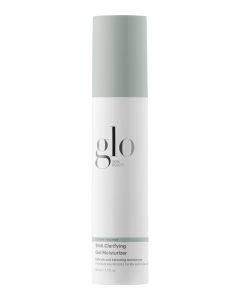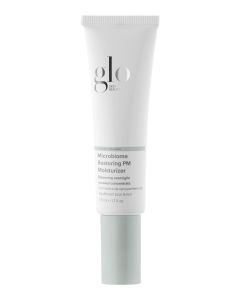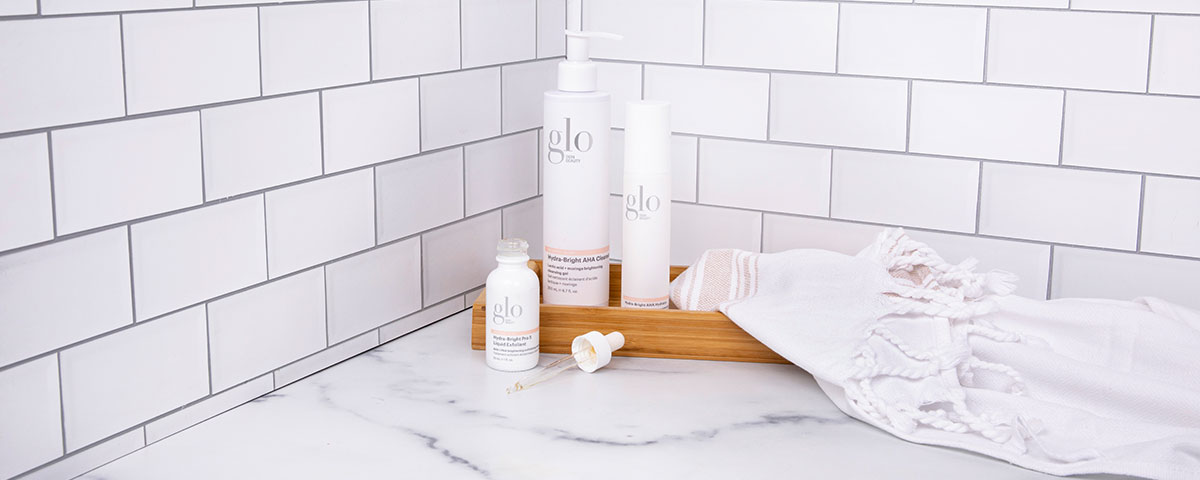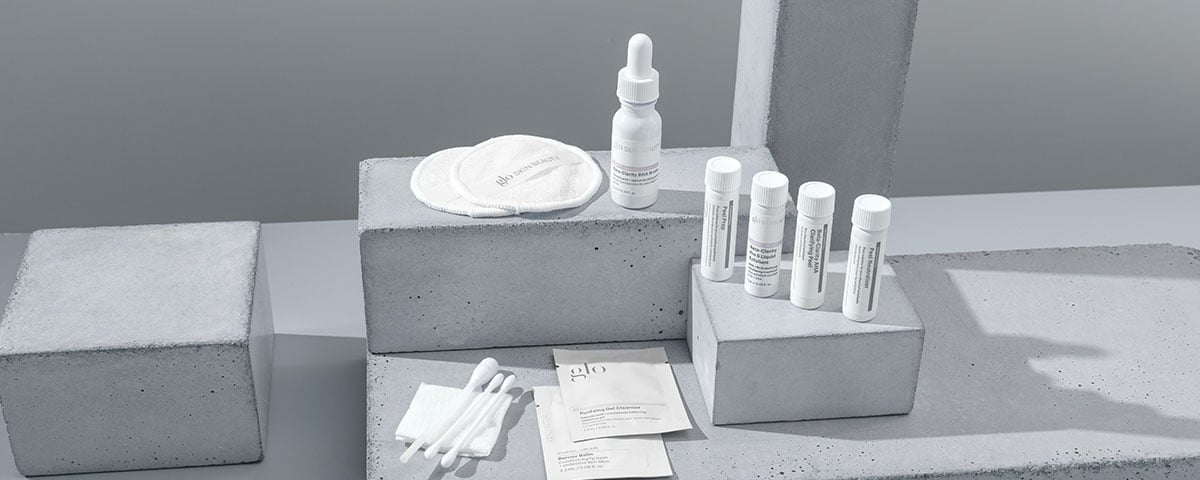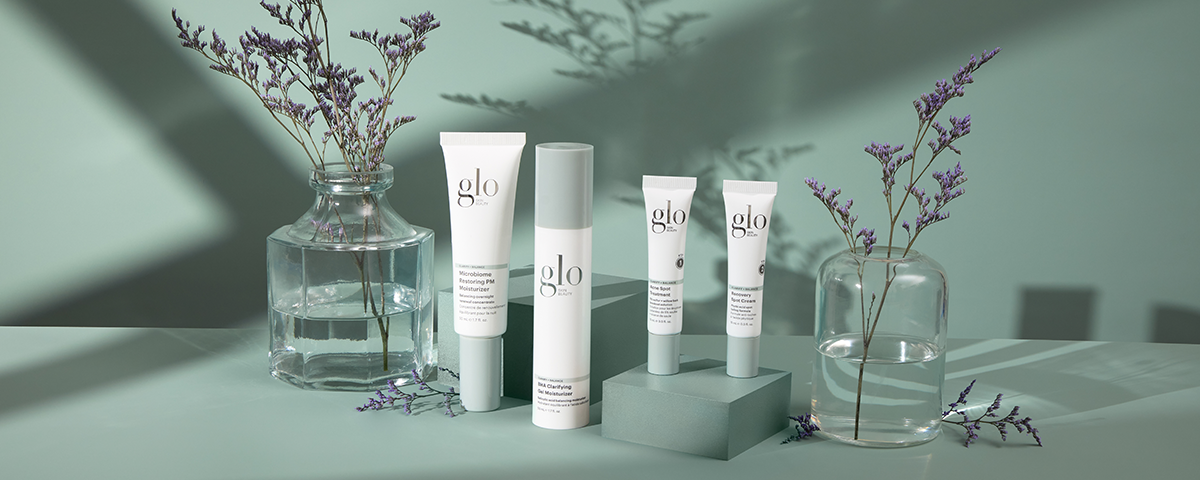
Acne Guide: How To Prevent Breakouts + Treat Acne
From blackheads to full-blown breakouts, acne is the most common skin condition in the U.S., affecting 85% of us at some point in our lives. And, adult acne is on the rise, affecting up to 50% of women aged 20-29 and 25% of women over 40 according to the American Academy of Dermatology. There are many reasons why we may experience acne including internal factors such as hormonal shifts or diet, while environmental factors can also play a role.
Whether mild or severe, cyclical or persistent, finding the best acne treatment to meet our specific skin concerns has been a long journey for many of us. But now, with a better understanding of the role of the skin’s microbiome and advanced formulations harnessing the power of microbiome balance, breakouts can be treated quickly and even prevented before they even form, with a focus on barrier repair and strengthening, for healthier, clearer skin, 24/7.
Step forward the Glo Acne Collection. Four transformative products designed to clear skin and banish breakouts fast for your most confident complexion clarity ever.
"Acne is so personal and can really affect an individual's confidence. explains Anna De La Cruz, Glo’s VP of Product Development. "At Glo, we pride ourselves in being problem-solvers by creating advanced, efficacious formulas that deliver results and help you meet your skincare goals. That's why we are so excited to introduce our new Acne Collection, which is the result of over two years of research on the skin’s microbiome and the special considerations an adult acne sufferer experiences. The results we have seen and the testimonials we have received about our new products, from real individuals who suffer from breakouts, are nothing short of incredible.
"If your skincare goals include banishing breakouts, refining your complexion, and controlling shine while supporting and strengthening your skin's barrier, get ready to fall in love with our new clinically-proven moisturizers and two specialty spot treatments packed with next-generation actives and microbiome supporting botanicals designed to deliver clear skin transformation."
In this acne guide, we’ll delve into all-things acne, the skin’s microbiome, other acne-fighting ingredients, and help you find everything you need to support your skin journey to consistent and confident complexion clarity.
Read on for the full acne guide...
What Are The Types Of Acne?
First up, understanding the types of acne will help you identify what’s happening to your skin, so you can target your treatments, treat your acne effectively, and safeguard skin from future flare ups.
Comedonal Acne
“There are two types of acne; inflammatory and non-inflammatory. Non-inflammatory or comedonal acne is clogged pores that look white because they’re closed under the surface, or black which are open at the skin’s surface,” explains Anna. This type of acne occurs when excess oils or sebum and dead skin cells get trapped in your pores.
- Micro-comedones: Clogged hair follicles or pores in the skin.
- Open comedones: More commonly known as blackheads. They occur when a clogged follicle reaches the surface of the skin and opens—basically the debris in your pore gets exposed to air, oxidizes, and takes on that black color.
- Closed comedones: Also known as whiteheads. These consist of a clogged hair follicle that stays beneath the skin, producing a white or flesh-colored bump.
Generally, these types of acne commonly appear on oily-prone areas of the skin like the T-zone.
Inflammatory Acne
“Inflammatory acne is anything that has that red, pus-filled, or cystic look to it. P-acne bacteria can overgrow and cause issues when there’s an excess of sebum or oil production on skin,” she adds.
If oil, dead skin cells, and other debris aren't effectively cleared out of pores and mix with naturally occurring bacteria, it can create an infection that causes visible swelling, redness, and the dreaded pus. This tends to happen on a deeper level than comedonal acne.
- Pustules: These are your traditional zits. They are usually red bumps with a ‘head’ filled with white pus. We’re often most tempted to squeeze these guys, which is a big no-no.
- Papules: Red bumps without the head.
Severe Inflammatory Acne:
This type of acne can be incredibly painful and as it occurs on the lower levels of your skin may need expert advice for treatment from a dermatologist, to avoid any scarring.
- Nodules: These are a sign of a more severe infection deeper into the skin. They appear as large, painful, solid lesions.
- Cysts: Deep, painful, pus-filled lesions, bigger and more painful. Often appearing around the jawline area.
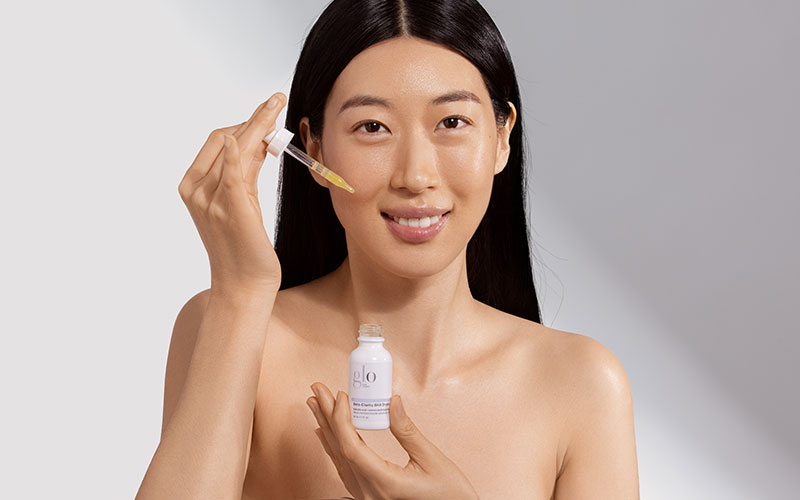
What is Adult Acne?
Adult acne refers to anyone 25 and over who experiences some form of acne or breakouts. “We’ve seen a huge uptick in incidences of adult acne globally and it’s certainly well beyond the adolescent phase,” explains Dr. Dendy Engelman, board-certified dermatologist. “And, we still have this idea that if I didn’t break out when I was younger, I won’t break out now that I'm older, but that isn’t the reality now unfortunately.”
So what causes adult acne? “Many of the same factors that contribute to adolescent acne, including excess oil, dead skin cells, acne-causing bacteria, and inflammation,” explains Anna. “Additional factors are also stress, hormones—our cycle, and lifestyle and diet too.”
Internal Factors
Excess sebum: "At the end of the hair follicle or pore, you’ll find sebaceous glands. These produce sebum, an oily substance that keeps skin hydrated, healthy, and protected. Some people naturally have more sebum-producing glands than others—oily skin types vs dry skin types, and with oilier skin types, these glands can overproduce oil which can then clog pores. That's why balancing and clarifying products will be your go-to," explains Anna.
Hormones: Women get acne at different times in their lives with hormone fluctuations. Pre-teen and teen are common, but increasingly women in their 30s, 40s, and even 50s are experiencing acne from fluctuations due to pregnancies and other hormonal surges. And, hormones aren’t just tied to our menstrual cycles, but also stress too. Stress can impact skin as much as other body systems and can cause a wide range of health issues.
Dead skin cells: “While hormones and sebum are often the main culprits in acne, debris like dead cells also contribute to clogged pores, which again lead to breakouts,” she shares. This is where regular exfoliation can really help prevent breakouts, and also treating the first signs of a breakout with a targeted treatment like our Acne Spot Treatment.
Diet: While studies are still being done on the effects of diet on acne, it's known that high sugar levels can contribute to spikes in hormones, which in turn lead to acne. There are also studies being done on the effects of caffeine, alcohol, and high fat diets and their effects on skin. Eating a healthy, balanced, fruit and vegetable-rich diet is always our recommendation, for optimal health and wellbeing.
External Factors
Environmental stressors: Free radical damage from the sun, pollution, heavy metals, and blue light, all can cause significant issues for our skin, including premature aging and inflammation. It contributes to potential breakouts by weakening our skin’s barrier and causing dead skin cells and debris to build up. Wearing SPF every day is vital in preventing premature aging. “For acne-prone skin a physical sunscreen like Oil-Free SPF 40+ is the perfect option. It offers high factor protection without clogging pores as it sits on the surface and bounces the sun's rays off skin like a shield. You’ll also benefit from adding an antioxidant vitamin C serum like C-Shield Anti-Pollution Drops into your daily routine as this offers robust skin-defense against those other environmental stressors.
Over-exfoliation: “This is a less common cause, but one worth considering," shares Anna. "Regular exfoliation is pivotal to treat acne and prevent breakouts, but over-exfoliation—as with anything you overindulge in, can cause inflammation, sensitivities, and trigger acne. It can damage the surface of the skin and the skin’s moisture barrier, so that’s also something to check in on when assessing acne, breakouts, or inflamed skin.”
How To Prevent Breakouts
Understanding the Skin’s Microbiome
The skin’s microbiome plays a crucial role in maintaining skin health. This complex ecosystem of microorganisms serve as our skin’s built-in line of defense and protection. Imbalances in the microbiome can contribute to the development of breakouts, while excessive sebum production can create an environment where acne-causing bacteria can thrive. “This is why Glo has focused on microbiome balance and skin barrier repair with the Acne Collection. Four next-generation formulations that work in synergy to strengthen, clarify, and restore skin for a healthy microbiome and to banish breakouts for good,” explains Anna.
Balancing Formulations
Making sure you're using balancing and refining formulations in your daily regimen like this advanced BHA Clarifying Gel Moisturizer is key. For daytime, pairing your skincare with a mattifying primer can help smooth the skin, control oil, and extend makeup wear without clogging pores. A lightweight, yet potent gel moisturizer, it delivers hydration and skin barrier repair, strengthening skin to absorb and retain deep moisture without clogging pores. In clinical tests, 94%* of participants said it noticeably controlled shine and oil, plus balanced their skin, and was gentle on their skin too after just 30 days of use.
Night Treatments
Washing your face properly at night is one of the best ways to prevent breakouts. If we skip this step or don't cleanse effectively, this can often be a big culprit in acne issues. “When we go to sleep at night our skin breathes and repairs, so if we leave a lot of oil, makeup, debris, or clogging products on our skin when we’re sleeping, we’re likely to wake up with congested skin or a new breakout”, shares Anna. Follow your cleanse with a salicylic and retinol serum like our Beta-Clarity BHA Drops, and follow with the ultimate nighttime treatment cream—Microbiome Recovery PM Moisturizer. In clinical tests, 98%* said they experienced less breakouts after using this cream in just 30 days, and 92% said it helped control and eliminate breakouts.
Treat Acne Fast
For breakouts that are starting to form; “Target them quickly with our Acne Spot Treatment. It treats that antibacterial component with sulfur and willow bark—a natural source of salicylic acid, and clears the breakout fast.”
For non-inflammatory acne like black and whiteheads, look to products that get into pores and exfoliate the skin. “Alpha hydroxy acids (AHAs) such as glycolic acid and lactic acid, plus retinol and niacinamide will really help clean and clear out the pores, plus prevent breakouts from reoccuring. For this you can’t go wrong with using Beta-Clarity Pro 5 Liquid Exfoliant up to three times a week. It contains five hydroxy acids at 10% concentration, plus niacinamide for an easy and effective exfoliation treatment that's super effective.”
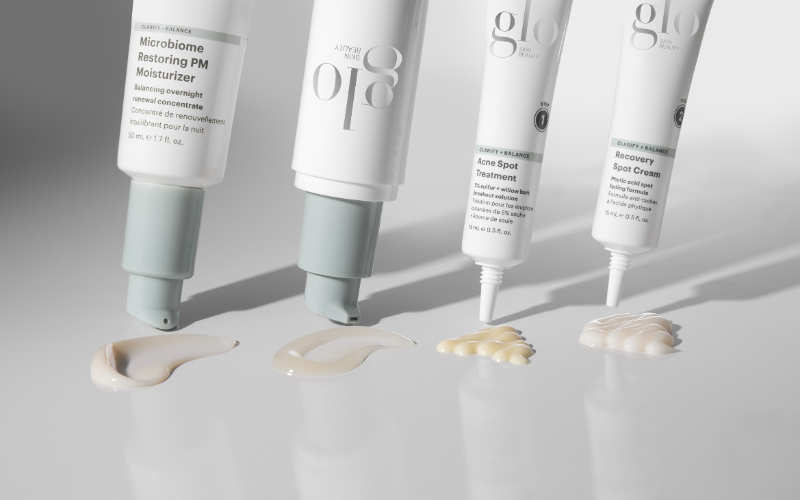
Ingredients To Treat Acne + Prevent Breakouts
Target the right ingredients for your skin’s needs so you can create your own acne prevention and treatment system. And, no, this doesn’t involve popping any zits. Letting them heal with the right treatments is key to avoid scarring or a prolonged breakout experience.
Acne-Fighting Ingredients
Salicylic Acid
Treats all types of acne.
What it does: “Salicylic acid is the expert at really tackling bacteria,” shares Anna. "It’s an oil-loving beta hydroxy acid or BHA, that stimulates exfoliation in the skin, clearing pores, and promoting new cell growth. It reduces inflammation, smooths skin’s surface and breaks down blackheads and whiteheads." Because it takes off the upper layers of skin it allows other active ingredients in a formula to penetrate more effectively.
What’s it in: You’ll find it in most acne-fighting clarifying products. And, when teamed up with retinol and glycolic acid in Beta-Clarity BHA Drops, this is truly the dream team in preventing and treating any breakouts, for smoother, clearer skin. You'll also find it in our breakout-banishing treatment Beta-Clarity Pro 5 Liquid Exfoliant, and advanced BHA Clarifying Gel Moisturizer,
Retinol
Treats all types of acne.
What it does: One of the best multitasking ingredients—there really isn’t much retinol can’t do, it penetrates skin cells and normalizes their behavior. It also stimulates cells deep in the basal layer, which push upwards causing a burst of exfoliation, helping keep the skin free of impactions. “I also love using retinol to treat acne as it gets into pores to clean out black and whiteheads and clear anything that might be brewing, so we aren’t only treating active acne but also getting rid of anything coming up from below,” she adds.
What’s it in: Again, Beta-Clarity BHA Drops have it teamed up with salicylic acid, but for a higher concentration that's more smoothing focused, GlyPro Retinol Drops will be your go-to. You can alternate between both serums to really get the most out of your acne-defense and smoothing, but avoid using both in one go. You can also do a monthly Retinol + C Smoothing Peel which delivers a clarifying, clearing boost to your daily routine.
Glycolic Acid
Best for treating comedonal acne.
What it does: Glycolic acid is a genius exfoliator, and as it’s a small molecule alpha hydroxy acid, it’s able to dive deep into skin sloughing off layers of dead skin cells, removing debris and oil from pores, for a major brightening boost. It doesn’t treat inflamed blemishes, but its exfoliating power will help clear out blackheads and whiteheads.
What’s it in: Try it in your morning cleanse with the Glycolic Resurfacing Cleanser, or find it teamed up with retinol in the GlyPro Retinol Drops, while for a more intensive monthly resurfacing treatment try our GlyPro AHA Resurfacing Peel for next-level retexturizing and glow boosting.
Sulfur
Treats all types of acne.
What it does: An acne treatment that dates back to ancient times, sulfur helps absorb excess oils (sebum) that may contribute to breakouts. It also helps remove dead skin cells, unclogging pores, promoting faster healing and recovery.
What’s it in: We feature it at 5% in our Acne Spot Treatment. A targeted treatment cream that works quickly to eliminate the first signs of a breakout, it'll be your first step in treating acne and can be followed by step 2—erasing the signs of that breakout using our phytic acid-powered Recovery Spot Cream.
Maintaining Clarity + Clear Skin
Keeping your complexion well nourished, hydrated, and maintaining your clarity will be a daily practice to keep those blemishes at bay. Here are some other helpful ingredients to look for.
Charcoal
Treats all types of acne.
What it does: “Charcoal is an effective ingredient in balancing as it has both antibacterial and anti-inflammatory properties, drawing out excess oils and impurities,” shares Anna.
What’s it in: Charcoal Detox Mask can be helpful in the treatment of both active acne and in preventing new breakouts. You can do this several times a week depending on what your skin needs.
Niacinamide
Treats all types of acne.
What it does: Niacinamide gets to work on the lining inside pores, preventing them from getting clogged. It clears the pores, tightening them up, and minimizing their appearance. It also helps balance oil production too, reducing breakouts.
What’s it in: Try our niacinamide-infused salicylic acid and retinol serum—Beta-Clarity BHA Drops for a clarifying, smoothing boost. For exfoliation, try Beta-Clarity Pro 5 Liquid Exfoliant powered by niacinamide and a blend of AHAs.
Azelaic Acid
Treats all types of acne.
What it does: It’s a versatile acid with anti-inflammatory and antibacterial properties. It clears out pores, while brightening uneven tone left behind from acne.
What’s it in: Boosting brightness when combined with alpha arbutin, the Hydra-Bright Alpha Arbutin Drops are also helpful in diminishing pigmentation left from acne marks.
And, as with all products, remember to give it time. It can take anywhere from 30-60 days for cell turnover to occur. This means that using a product for a week or two isn’t going to cut it. If you want to see results, you need to stick with your regimen for at least one month before you can determine whether or not to continue with a certain product. That said, if you experience an immediate negative reaction from a product, don’t continue using it.
Treating Acne Marks
Like the party-crasher it is, acne can leave marks behind after it’s gone. These are known as post-inflammatory marks or erythema and can be red or brown. The deepest mark is an acne scar which is a deep disruption of collagen. This can be pitted with indentation or hypertrophic with an overgrowth of skin.
“If you have residual inflammation, the best at-home product to treat it is Recovery Spot Cream. It’s powered by phytic acid to reduce any pigmentation, plus hydrating and nourishing botanicals to soothe and replenish any lost moisture. We recommend it as a second step to follow up after treating an active breakout with our Acne Spot Treatment.”
Other key ingredients to look for when treating pigmentation are vitamin C, alpha arbutin, and AHAs.
“Another key product to pair with this is sunscreen. Redness and brown spots will be made darker by sun exposure, so protection is important to avoid making it worse. You should be using SPF daily, regardless of any residual inflammation,” adds Anna.
*Results reported after one month independent clinical studies conducted on 35 healthy female and male volunteers, average ages 30-32 years old.

